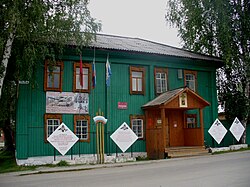Military commissariat


A military commissariat (from
In Soviet Russia / Soviet Union
A military commissariat (Russian: Bоенный коммисариат, translit: voyenny kommisariat) was a local military administrative agency used in the Soviet Union to provide
The structure and function of military commissariats initially developed between 1917 and 1922 during the
Military commissariats organised the mobilisation of troops before the Soviet invasions of
After 1945, military commissariats and their administrative processes were increasingly monitored closely by the United States through espionage to establish greater understanding of the Soviet Armed Forces.[6] This is a result of the bookkeeping and accounting information held by individual military commissariats regarding population, recruitment and equipment numbers in their districts.[citation needed]
In the 20th century the Soviet Union was considered a major military strength.

Current use
Following the
In Russia
Military commissariats fulfil the same roles in Russia as they did in the Soviet Union and continue to operate in their individual districts. They recruit servicemen to the Russian Army and choose who is eligible and ineligible for service.[9] Konstantin Preobrazhensky, a former KGB colonel and intelligence expert, has suggested that military commissariats in Russia enlist and report individuals to the FSB and the police as well as to the military, similarly to Soviet times.[10] Political and social debate regarding a transition to an all-volunteer professional military service model exists in Russia and in this context the purpose of the military commissariat is questioned. Most people who consider themselves Soviet patriots oppose the abolition of forced conscription.[9]
Since the decrease in military expenditure and regulation that occurred during the 1990s, military service programs and institutions such as military commissariats have faced accusations of corruption.[9][8][2] The quality of military service and training is also believed to have decreased.[7] Military commissars allegedly accept bribes to exempt individuals from compulsory military service and this method of avoiding conscription along with others such as attaining false medical certificates contribute to the common concern of draft evasion. This is seen as a continuation of Soviet traditions, when children of nomenklatura were exempt from military service.[9] Another contentious issue regarding military commissariats and military commissars in modern Russia is the continued use of Soviet portmanteaus and phraseology in the words 'voyenkom' (military commissar) and 'voyenkomat' (military commissariat). This has been regarded as a form of Soviet nostalgia.[8]
The military in Russia has become increasingly unpopular amongst Russian citizens, with a 2011 Levada Centre study finding that 54% of Russian parents would not want their son to join the army.[9] Additionally, the military has a legacy of hazing and brutality in the form of dedovshchina that stretches back to the 1920s.[8] This reputation negatively connotes back to the role of military commissariats in conscription, and its effect of increased draft evasion.[9] These concerns were illuminated by the creation and mainstream popularity of human rights organisations such as the Union of the Committees of Soldiers' Mothers of Russia, which seeks to expose the abuses experienced by men in the Russian military.[11] In 1998, human losses in the Russian army were over 15 000, with every fourth death being a suicide.[11] Anna Politkovskaya, a Russian journalist and activist, has provided anecdotal information regarding the concerns of many families in response to conscription and the ways men are drafted by military commissariats.[12] Volunteers from the committee also make routine visits to military commissariats to ensure procedures are correct and to oversee developments. This is accepted in military commissariats in the interests of continuing military reform and minimising corruption.[11]

In post-Soviet states
After the dissolution of the Soviet Union, all
Other uses
In other European countries
The word
In Britain, military commissariats were used first in the Crimean War between 1853 and 1856.[14] They were created as a part of the Treasury and were responsible for transporting and rationing all food, fuel and provisions from Britain to dispatched troops in Crimea as well as organising and accounting for all relevant documentation regarding supply quantities and their destinations.[14] This system and its procedures were criticised by members of the British Army at the time of the Crimean War and has been criticised by military historians since for being inefficient as there were food shortages experienced by British soldiers during the Crimean War.[14] The food shortages are attributed to the military commissariat structures that required documentation to be provided by military commanders and their soldiers that in most cases was not properly provided in time.[14] This British system was inefficient in comparison with the equivalent French intendance militaire.[15] The chain of command was also criticised at the time as it was thought that the commissariats should respond to the War Department and not to the Treasury.[14] Commissariats were transferred to the authority of the War Department in December 1854.[15] This process represented a militarisation of what was the initially uniquely administrative commissariat system.[15] However, the guidelines and bureaucracy used by military commissariats during the Crimean War provided consistency and uniformity to the procedures during the war which Britain ultimately contributed to winning.[14]
See also
- 2022 Russian military commissariats attacks
References
- ^ ISBN 9780674497443.
- ^ PMID 32834128.
- ^ ISBN 0891582762.
- ^ S2CID 151291671.
- ^ ISBN 0-203-01105-8.
- ^ Defence Intelligence Agency, 1982, Intelligence Appraisal USSR: Oblast Military Commissariat Activity, accessed 31 December 2023, via Central Intelligence Agency Electronic Reading Room.
- ^ ISBN 9780691128962.
- ^ S2CID 62805983.
- ^ S2CID 154709663.
- ^ a b c Preobrazhensky, K. 2009. South Ossetia: KGB Backyard in the Caucasus. The Central Asia-Caucasus Analyst. http://www.cacianalyst.org/publications/analytical-articles/item/11799-analytical-articles-caci-analyst-2009-3-11-art-11799.html
- ^ ISBN 9781315038506.
- The Harvill Press: London.
- ProQuest 1560536085.
- ^ S2CID 143607539.
- ^ doi:10.16995/ntn.707.
